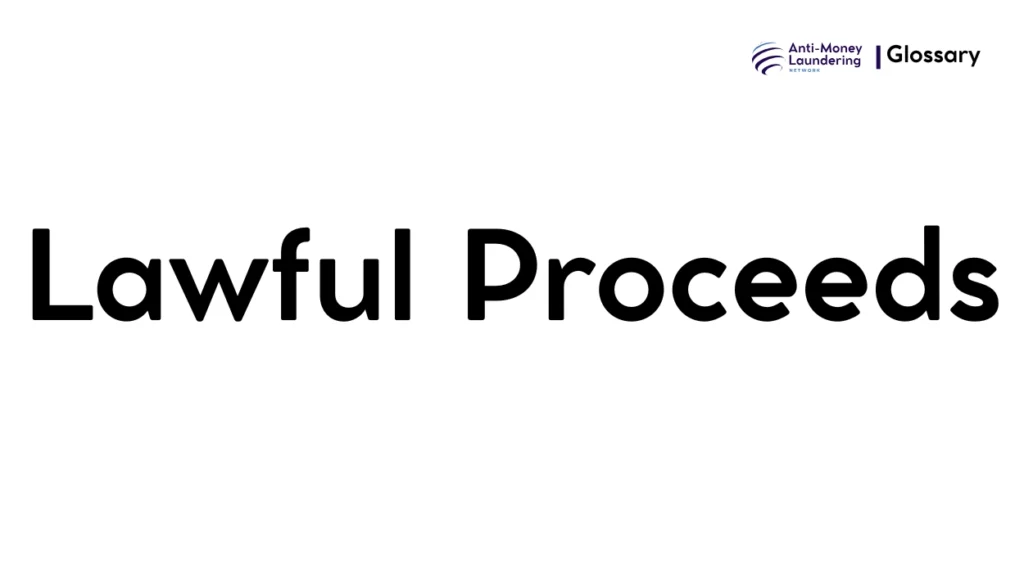Definition
Lawful Proceeds refer to assets, funds, or property obtained through legitimate and legal means, as opposed to illicit or criminal sources. In AML terms, these are proceeds that do not originate from criminal activities and thus are not subject to money laundering prohibitions. Recognizing lawful proceeds helps distinguish legal financial flows from suspicious or illegal ones.
Purpose and Regulatory Basis
Role in AML
Identifying lawful proceeds is crucial to AML efforts as it aids in distinguishing legitimate funds from those derived from criminal activities, which need to be detected, monitored, and reported. Financial institutions must establish the legality of proceeds to prevent the integration of illicit funds into the financial system.
Regulatory Framework
Key global and national regulations emphasizing the concept of lawful proceeds include:
- FATF Recommendations: Set international standards for AML, including defining proceeds of crime and promoting measures to identify lawful funds.
- USA PATRIOT Act: Enhances AML requirements to detect illicit funds and protect financial systems.
- European Union AML Directives (AMLD): Define proceeds and set regulatory obligations to combat money laundering and terrorist financing.
These frameworks require institutions to implement controls and due diligence to confirm the lawful source of customers’ funds and transactions.
When and How it Applies
Real-World Use Cases
- Customer Due Diligence (CDD): Establishing the source and nature of funds to verify they are lawful.
- Transaction Monitoring: Flagging transactions inconsistent with lawful proceeds.
- Onboarding and Ongoing Monitoring: Continuous assessment of clients’ financial activities to ensure ongoing compliance.
Triggers
Indicators include unusual transaction patterns, sudden wealth inconsistent with business operations, or involvement in high-risk sectors or jurisdictions.
Types or Variants
While the term primarily denotes funds lawfully acquired, it can be further classified by:
- Source-Based Classification: Income from salaries, investments, business revenues.
- Form-Based: Cash, electronic transfers, physical assets.
Institutions may categorize lawful proceeds during risk assessments to tailor monitoring strategies.
Procedures and Implementation
Compliance Steps
- Risk Assessment: Evaluate potential risks associated with customers and products.
- Customer Identification and Verification: Obtain documents proving lawful income and activities.
- Source of Funds Verification: Review transaction history, employment, business activities.
- Ongoing Monitoring: Track transactions for consistency with lawful proceeds.
- Record Keeping: Maintain documentation to support lawful source assertions.
Systems and Controls
Automated monitoring systems help detect anomalies, supported by trained AML officers tasked with investigations and reporting.
Impact on Customers/Clients
Customers must provide transparent, verifiable evidence of their funds’ lawful origin. Restrictions exist where documentation is insufficient or suspicions arise. Respect for privacy and compliance balance is essential to maintain trust.
Duration, Review, and Resolution
Institutions undertake:
- Periodic Reviews: Reassessing risk profiles and sources of funds.
- Event-Triggered Reviews: When new information or suspicious activity is detected.
- Resolution Actions: Reporting suspicious transactions, freezing assets when warranted.
Reporting and Compliance Duties
Financial institutions must:
- Submit Suspicious Activity Reports (SARs) if funds appear illicit.
- Maintain robust audit trails for compliance verification.
- Face penalties for failure to adequately verify and report dubious proceeds.
Related AML Terms
- Proceeds of Crime: Illicitly obtained assets subject to AML scrutiny.
- Customer Due Diligence (CDD): Process to verify clients and their funds.
- Suspicious Activity Reports (SARs): Mandatory reports on suspicious transactions.
Understanding lawful proceeds enhances the effectiveness of these related areas.
Challenges and Best Practices
Common Issues
- Difficulty verifying true source amid complex structures.
- Balancing thoroughness with customer privacy.
- Keeping up with evolving regulatory requirements.
Best Practices
- Employ risk-based approaches tailored to client profiles.
- Use advanced analytics and technology for transaction monitoring.
- Maintain continuous training for staff.
Recent Developments
- Technological Innovations: AI and machine learning for better detection.
- Stricter Regulations: Expanded scope under revised AMLDs.
- International Cooperation: Enhanced data sharing between jurisdictions.
Understanding and correctly identifying lawful proceeds is fundamental in AML compliance. It enables institutions to prevent illicit funds entering the financial system, uphold legal integrity, and meet regulatory obligations.

